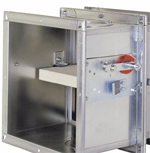 New European fire standards due to be adopted into UK Building Regulations this year (2007) are set to transform the UK fire damper market, potentially making the popular shutter-type fire damper used in countless UK installations redundant.
New European fire standards due to be adopted into UK Building Regulations this year (2007) are set to transform the UK fire damper market, potentially making the popular shutter-type fire damper used in countless UK installations redundant.
Fire damper systems in the UK are totally different from those in Europe. The shutter fire damper used in the UK for the past 50 years is rather like a factory roller shutter door. Fire damper blades are made from inter-woven stainless steel and the blade stack is held in the open position by a fusible link. When this is broken by the elevated temperature resulting from a fire, the blade stack shuts with the assistance of a roller spring.
In Europe, fire dampers are more likely to employ a single blade with a central pivot. The blade is insulated to prevent heat transfer.
Comparing the principal features of both products, we can see that the characteristics of the shutter fire damper are:
• It is prone to jamming, particularly if the maintenance regime is not strict.
• For the fire damper to operate the main fans have to be shut down.
• Once it is fired (in other words, when it closes), it is very hard to open.
• It can’t be controlled remotely.
• In the event of fire it has a high surface blade temperature.
• Stability is questionable when it is mounted horizontally.
The European blade fire damper, on the other hand, has a central pivoted blade which allows it to be shut against the fan pressure since the aerodynamic forces are such that they can assist closing once it has been moved from the horizontal position. It also has other advantages:
• It can be controlled remotely by using electrical actuators or smoke detectors.
• It is easy to re-set from the outside of the casing.
• It has an insulated blade to prevent fire transfer.
• It has a simple mechanism which can be checked from outside the damper.
The traditional shutter damper found in the UK would fail European standards in terms of integrity, insulation and leakage.
The biggest difference between the current UK standards and the European standards that are likely to replace them this year is that the new standard requires a negative pressure of 300Pa and a maximum leakage of 56 l/s/m², whereas there are no specific requirements for these features in the current UK standard.
Trox Germany has proved that shutter fire dampers cannot meet the European standard, but the single blade fire damper can. The facts therefore point quite clearly to a greater use of the European type of fire dampers with the demise of the shutter fire damper.
This, in my opinion, is good news for the UK – a single death under any circumstances is one death too many, but fatalities caused by fire are particularly tragic because, in most cases, they can be prevented.
We can’t, of course, prevent fire, but fire dampers can help prevent its spread so that the fire brigade has sufficient time to evacuate the building.
The prevention of the spread of fire is essentially achieved in four ways:
• The proper orientation of fire compartments.
• Automatic closure of openings in walls and ceilings.
• The installation of fire alarms and extinguishing systems.
• The fireproof arrangement of installations.
The first three are dealt with by architects and engineers, but the last – fireproof installations (including in ducts for air conditioning systems) – is catered for by companies such as Trox.
Multi-storey buildings contain vertical and horizontal air ducts to supply and extract air. Even if the fire brigade has defined certain fire compartments, the air ducts still run through them. This means that fire can easily be spread around the building if we take no action.
Even if we close off one section – say between fire compartments A and B – if a fire occurs in compartment A the air duct will be heated quickly to 800-900°C and the metal duct will cause heat conduction through the wall into compartment B. Radiation and self-ignition can then cause combustible materials to catch alight in compartment B. We therefore need to prevent heat conduction with insulation.
But this is not the only way that fire can spread. Another possibility is that the hot metal of the ducts can fail, causing gaps in the wall. These gaps can allow hot gases to cross between compartments through the wall which then start a fire. The cure here depends on integrity – we need to look not only to the damper but also to the construction of the wall and fire damper.
A third possible failure can occur as expanding forces from the air duct into the wall caused by extremely hot temperatures on the fire side can break the wall and allow fire to breach compartments. The key point here, too, is integrity using expansion joints and flexible connectors which burn off in the case of fire to neutralise expansion forces.
All these fire compartment breaches can be minimised with good housekeeping, keeping the duct free of dust, dirt and oil.
However, this is clearly not enough on its own. The cause of fire disasters often lies in the failure to comply with fire protection regulations and guidelines.
Optimal fire protection is only achievable if architects, consultants and authorities jointly prepare a fire protection concept appropriate to the building in the planning stage.
